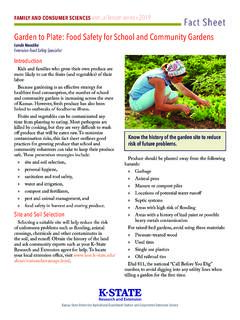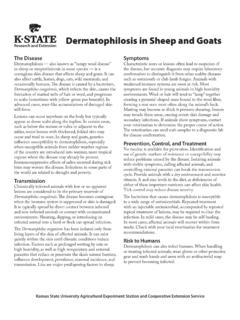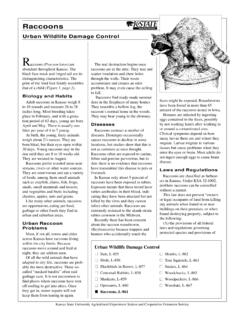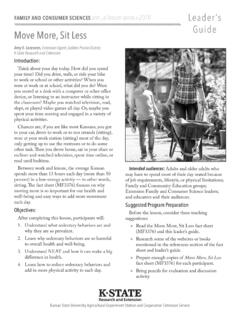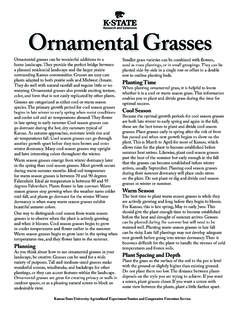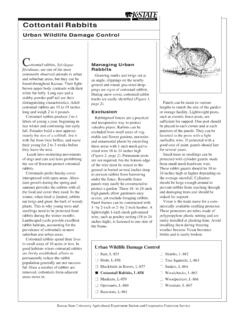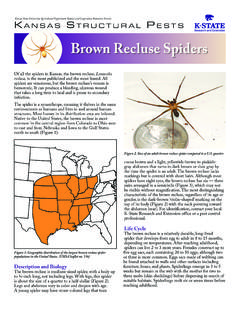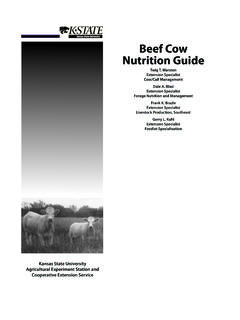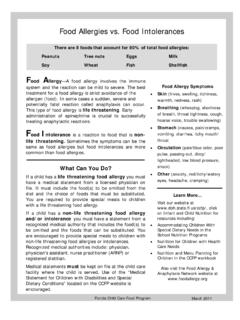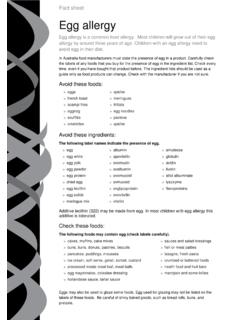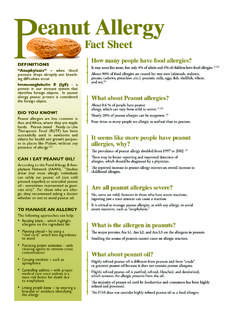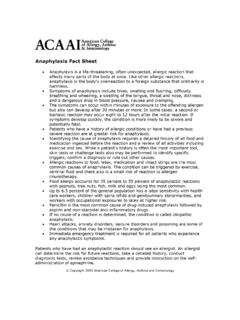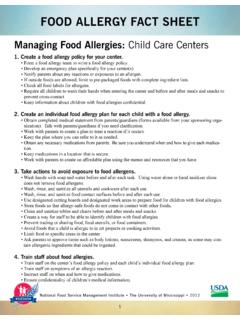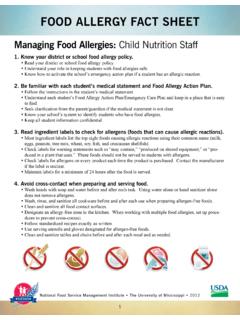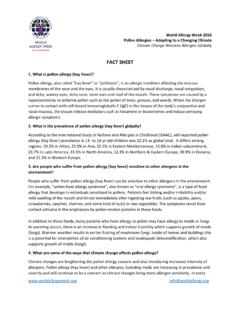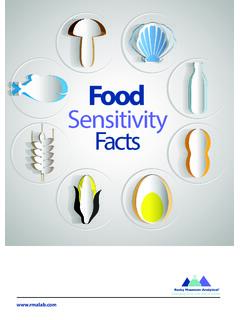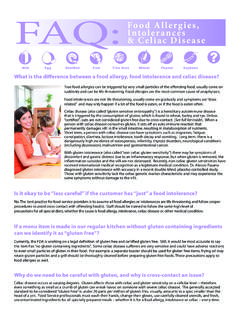Transcription of MF3083 Food Allergy Facts of Life, Fact Sheet
1 Kansas State University Agricultural Experiment Station and Cooperative Extension ServiceIntroductionLiving with food allergies is challenging, requiring adults to manage their health and avoid trigger foods, and parents to recognize symptoms and find helpful resources and professionals. It also means finding ways to manage you or your child s health and well-being without hardship, stress, or illness. Learning to recognize a food Allergy or food sensitivity is as important as learning how to live with Allergy BasicsThe science behind it allThe body has an amazing immune system that allows it to fight off many harmful microorganisms. One way the immune system attacks invaders is to make a protein called an immunoglobulin antibody that can recognize an invader. Immunoglobulin antibodies are programmed to attach to certain shapes in the bloodstream and organs. There are a variety of types of immunoglobulins (Ig), but the one known as IgE is the most troublesome for Allergy sufferers.
2 IgE cells make up immune system worker cells called mast cells, which are found in the respiratory tract, intestines, skin, and other organs. The role of IgE is to protect the body from infection by recognizing proteins. Sometimes IgE gets misdirected and attacks the harmless proteins in pollen, animal dander, or food , which causes the chemical histamine to be released in the body, creating common allergic reactions: hives, itching, rashes, sneezing, gastrointestinal upsets, and lots of discomfort. In short, a food Allergy is a strong but misdirected immune response. fact SHEETFood Allergy Facts of life Amy Lorenzen, Family & Consumer Sciences Agent,K-State Research and Extension - Golden Prairie DistrictDiagnosing a food AllergyThe only way to diagnose a food Allergy is to have an Allergy test that determines which foods your body reacts to. Your family doctor can refer you to an allergist, a specialist who knows the correct way to test for allergies.
3 One of the things an allergist will use to diagnose a food Allergy is a detailed medical history. Share information with your allergist about past illnesses or food reactions. It is important to try and remember all situations where a food Allergy may have been the cause of your symptoms for use in conjunction with actual food Allergy are two types of tests available for diagnosing food allergies: the skin prick test and the food -specific blood test. The skin prick (or wheal and flare ) test is a quick, accurate, and relatively painless way to detect food allergies in people of all ages. Allergists use a tiny plastic probe with a sharp tip to scratch the surface of the skin and then place a drop of liquid food extract on the skin. If you are allergic to a certain food , a wheal or bump will appear. This bump is the reaction of your body to the food , and often will be red and itchy. The allergist will score the wheals based on a scale to determine your reaction to a food .
4 To prepare for the test, you must avoid medications such as antihistamines, which can interfere with the test results. The blood test to determine a food Allergy is called a RAST or radioallergosorbent test, which uses a blood sample placed in different tubes that contain different foods and a protein that glows in the dark. By measuring the amount of glow, the laboratory determines the amount of antibody response for a specific food protein in the blood stream. There are some disadvantages to using the RAST test: some people, especially children, are sensitive to blood tests; the results are not instant, unlike the skin test; and it is often more costly than the skin-prick Allergy your allergist does to help you determine your food Allergy , it may give you peace of mind to finally know what foods you are allergic to. There is no cure for a food Allergy . The only way to control it is to strictly avoid the food (s).
5 People with a food Allergy must be aware of the presence of the allergen(s) in their diets and of household and personal products that are made with these foods. A child with an Allergy to egg, milk, soy, or wheat may eventually outgrow it. Consult your health-care provider about this following eight foods cause 90 percent of the allergic reactions in the United States: eggs fish milk peanuts shellfish soy tree nuts (almonds, beechnut, brazil nut, bush nut, butternut, cashew, chestnut, coconut, filbert, ginko nut, hazelnut, hickory nut, lichee nut, macadamia nut, nangai nut, pecan, pine nut, pistachio, shea nut, and walnut) wheatA food Allergy occurs when the immune system attacks a food protein. Ingesting the offending food may trigger the sudden release of chemicals (including histamine) resulting an allergic reaction. The symptoms may be mild (rashes, hives, itching, swelling, or similar symptoms ) or severe (trouble breathing, loss of consciousness, and other serious symptoms).
6 A food Allergy can be potentially of a food AllergySymptoms of a food Allergy occur shortly after eating. One or more of the following may occur within minutes after eating: trouble swallowing, shortness of breath, repetitive coughing, voice changeadministering the medications quickly, can help you deal with an Allergy -related attack. A written food Allergy Action Plan should be prepared and kept with you always (see supplemental information at ).If your child has a food Allergy , you must be extra aware of what your child eats and he or she comes in contact with. You should distribute the food Allergy Action Plan to all school personnel, including teachers, principals, bus drivers, lunchroom help, cooks, and teacher aides and help your child understand the importance of his or her food Allergy . Remember the three R s Recognize the symptoms, React quickly, and Review what caused the reaction and how well the action plan worked.
7 Keep a food diary of what and where you and your child eat to help you find the causes of your symptoms. Read Ingredient LabelsReading labels on food products, cosmetics, bath products, laundry detergents, and other items that you come in contact with is very important, as these products often contain eggs, milk, soy, or other allergens. Recognizing the various names of the allergen that you are allergic to is crucial (see supplemental information about how to read a food label at ). Always read the ingredient label when you purchase a food , cosmetic, body care item, or household item. Manufacturers change the ingredients of their products frequently, and such changes are not always evident by looking at the front of a package. Remember, allergens are in many non- food items such soaps, shampoos, hair sprays, skin products, medications, and pet foods. Follow Avoidance StrategiesCareful food preparation is a must.
8 Wash hands, cooking utensils, and food preparation surfaces to avoid reactions from trace amounts of proteins left behind, which can trigger an Allergy attack. Eating out is often a stressful and frightening experience when you have a food Allergy . According to the food Allergy and Anaphylaxis Network, hidden ingredients and cross-contact contamination are common causes of food -allergic reactions in restaurants. If you dine away from home, be vigilant about verifying ingredients and preparation methods. Speak to the restaurant manager about menu items. Do not be afraid or embarrassed to tell your nausea and vomiting, diarrhea, abdominal cramping swelling, hives, eczema, itchy red rash drop in blood pressure, loss of consciousnessEach person with a food Allergy has a specific threshold a specific dose of the food that initiates the allergic reaction. A person s tolerance level can fluctuate the reaction-causing dose may change over time, and the individual may become more sensitive when his or her immune system is already fighting an is a rapid, serious allergic reaction that may cause death.
9 During a food -induced allergic reaction, the most common part of the body affected is the skin. A person may develop hives (where the skin becomes bumpy and red) or experience swelling on the lips and eyelids. The gastrointestinal tract is the next most likely affected system, with symptoms such as an itchy mouth, stomachache, nausea, vomiting, and a food AllergyIf you have had a serious allergic reaction in the past to a food , it is vital that you carry a rescue device containing epinephrine (adrenaline). Consult your health-care provider about its proper use. Prompt administration of epinephrine is essential to surviving anaphylaxis. Awareness of the foods that you or a loved one is allergic to is essential. It is imperative for your or your loved one s safety that you read ingredient labels on foods, household, and personal products and understand the various names for each offending food allergen. At this time, there are no medications to prevent food allergies, only some that control symptoms after a reaction occurs.
10 Thus, strict avoidance of the Allergy -causing food is the only way to prevent an allergic reaction. Even if you like the taste of the food you are allergic to, you should avoid that food in all its forms. To successfully manage your food Allergy , your diet and lifestyle must change. The ways to maintain control over a food Allergy are: plan how to handle difficult situations, read ingredient labels vigilantly, and follow avoidance strategies while preparing or eating food . Develop a PlanAllergic reactions are never planned. If your doctor has prescribed medication with epinephrine, you must carry it with you at all times. Always be prepared for an allergic reaction by keeping your medications immediately available at all times. Knowing and recognizing the symptoms, as well as server about your food allergies (see supplemental information on the Chef s Card, available at ). food IntoleranceFood intolerance, unlike food Allergy , does not involve the immune system and is not life -threatening, but it can still cause a lot of pain and disrupt your lifestyle.
